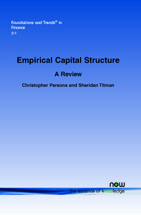Empirical Capital Structure: A Review
By Christopher Parsons, University of North Carolina at Chapel Hill, USA, Chris_Parsons@kenan-flagler.unc.edu | Sheridan Titman, University of Texas at Austin, USA, Sheridan.Titman@mccombs.utexas.edu
Abstract
This survey provides a synthesis of the empirical capital structure literature. Our synthesis is divided into three parts. The first part examines the evidence that relates to the cross-sectional determinants of capital structure. This literature identifies and discusses the characteristics of firms that tend to be associated with different debt ratios. In the second part, we review the literature that examines changes in capital structure. The papers in this literature explore factors that move firms away from their target capital structures as well as the extent to which future financing choices move firms back toward their targets. Finally, we complete our review with a set of studies that explore the consequences of leverage, rather than its determinants. These studies are concerned with feedback from financing to real decisions. For example, we explore how a firm's financing choices influences its incentive to invest in its workers, price its products, form relationships with suppliers, or compete aggressively with competitors.
Empirical Capital Structure
The firm's capital structure - how it funds operations by raising capital from a variety of sources – has attracted considerable attention from both academics and practitioners. The empirical capital structure literature explores both the cross-sectional determinants of capital structure as well as time-series changes. Empirical Capital Structure reviews both aspects of this literature. Empirical Capital Structure is organized around a simple framework that contains three key ingredients: the costs and benefits that determine a firm's capital structure; the existence of shocks that cause firms to deviate, at least temporarily, from their targets; the presence of factors that may prevent firms from constantly maintaining debt ratios that match their targets. Empirical Capital Structure is organized as follows. Section II discusses specification and econometric issues that will be important for many of the tests considered. Section III reviews cross-sectional capital structure determinants. Section IV explores factors that pull firms away from their leverage targets. Section V discusses reasons why firms might not immediately reverse the effect of these leverage shocks, apparently allowing deviations from their targets to persist for extended periods of time. Section VI explores a group of studies that look at how leverage feeds back into a firm's real business decisions. Finally, Section VII concludes and provides suggestions for new research.
